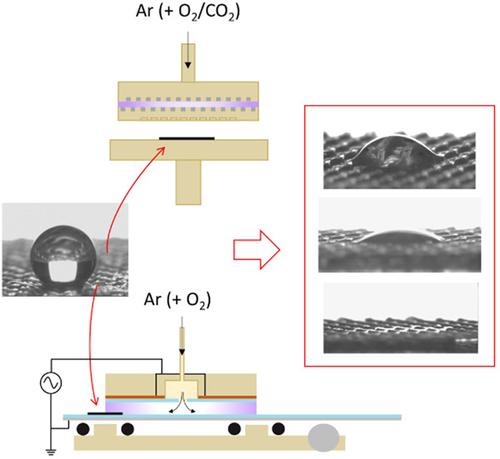当前位置:
X-MOL 学术
›
Plasma Processes Polym.
›
论文详情
Our official English website, www.x-mol.net, welcomes your
feedback! (Note: you will need to create a separate account there.)
Tuning the wicking and wettability properties of PET textiles by DBD or a remote atmospheric RF torch: A comparison
Plasma Processes and Polymers ( IF 2.9 ) Pub Date : 2021-03-30 , DOI: 10.1002/ppap.202100005 Annaëlle Demaude 1 , Rosanna Inturri 2 , Cristina Satriano 3 , Perrine Leroy 4 , François Reniers 1
Plasma Processes and Polymers ( IF 2.9 ) Pub Date : 2021-03-30 , DOI: 10.1002/ppap.202100005 Annaëlle Demaude 1 , Rosanna Inturri 2 , Cristina Satriano 3 , Perrine Leroy 4 , François Reniers 1
Affiliation

|
Textile industry is constantly searching for easy and rapid ways to improve the properties of textiles. In this matter, plasma treatments have already proven to be an efficient and green solution, as they proceed in a dry environment and require minimal use of chemicals. To date, most of the work on the subject has been performed with low-pressure plasmas. Recently, atmospheric plasmas have received increasing interest, especially for industrial applications. Indeed, the possibility to avoid the use of pumping systems makes this technology easily implementable in continuous in-line processes. For many applications, the treatment aims at modifying the textile surface to increase the overall hydrophilicity. The latter is often probed by the water contact angle, but this does not always reflect the global hydrophilic behavior of the textile as a three-dimensional material. A complementary study of the wicking properties is important to better reflect the penetration of liquids into the textile, but it is poorly reported in the literature. The present work aims at increasing the water uptake of polyethylene terephthalate (PET) textile by direct or remote plasma treatment, which are the two main trends in this field. For this purpose, a dielectric barrier discharge (DBD) and a radiofrequency plasma torch at atmospheric pressure are used, respectively. Different plasma parameters are varied and their respective effect on the wicking properties of the fabric, assessed by an absorbency test developed ad hoc, are correlated to their surface chemical composition determined by X-ray photoelectron spectroscopy. These results are compared with the possible changes in wetting of the fiber surface witnessed by water contact angles measured on PET foil samples submitted to the same plasma treatments. Complete wicking of water in PET textile can be obtained after 20 or 10 s of torch treatment with pure Ar plasma or Ar/O2 mixture, respectively. However, a comparable effect is detected, after 30 s of DBD Ar plasma treatment, under the used experimental conditions. Besides, the addition of O2 to the discharge has an opposite effect on the fabric wicking. These results are discussed in terms of the peculiar processes in surface activation and modification of the fabric surface triggered by the two different plasma technologies.
中文翻译:

通过 DBD 或远程大气 RF 炬调节 PET 纺织品的吸湿性和润湿性:比较
纺织业一直在寻找简单快速的方法来改善纺织品的性能。在这方面,等离子处理已被证明是一种高效且绿色的解决方案,因为它们在干燥的环境中进行并且需要最少的化学品使用。迄今为止,该主题的大部分工作都是用低压等离子体进行的。最近,大气等离子体受到越来越多的关注,尤其是在工业应用中。事实上,避免使用泵送系统的可能性使得该技术可以在连续在线过程中轻松实施。对于许多应用,该处理旨在修饰纺织品表面以增加整体亲水性。后者通常由水接触角探测,但这并不总是反映纺织品作为三维材料的整体亲水行为。对芯吸特性的补充研究对于更好地反映液体渗透到纺织品中很重要,但在文献中却鲜有报道。目前的工作旨在通过直接或远程等离子体处理来增加聚对苯二甲酸乙二醇酯 (PET) 纺织品的吸水率,这是该领域的两个主要趋势。为此,分别使用介质阻挡放电 (DBD) 和大气压下的射频等离子体炬。不同的等离子体参数是变化的,它们对织物芯吸特性的各自影响,通过专门开发的吸收性测试进行评估,与通过 X 射线光电子能谱确定的表面化学成分相关。将这些结果与在经过相同等离子体处理的 PET 箔样品上测量的水接触角所见证的纤维表面润湿的可能变化进行比较。使用纯 Ar 等离子体或 Ar/O 进行 20 或 10 秒的火炬处理后,可完全吸干 PET 纺织品中的水2混合物,分别。然而,在使用的实验条件下,在 DBD Ar 等离子体处理 30 秒后检测到类似的效果。此外,将O 2 添加到放电中对织物芯吸具有相反的影响。这些结果根据由两种不同等离子体技术触发的织物表面表面活化和改性的特殊过程进行了讨论。
更新日期:2021-06-05
中文翻译:

通过 DBD 或远程大气 RF 炬调节 PET 纺织品的吸湿性和润湿性:比较
纺织业一直在寻找简单快速的方法来改善纺织品的性能。在这方面,等离子处理已被证明是一种高效且绿色的解决方案,因为它们在干燥的环境中进行并且需要最少的化学品使用。迄今为止,该主题的大部分工作都是用低压等离子体进行的。最近,大气等离子体受到越来越多的关注,尤其是在工业应用中。事实上,避免使用泵送系统的可能性使得该技术可以在连续在线过程中轻松实施。对于许多应用,该处理旨在修饰纺织品表面以增加整体亲水性。后者通常由水接触角探测,但这并不总是反映纺织品作为三维材料的整体亲水行为。对芯吸特性的补充研究对于更好地反映液体渗透到纺织品中很重要,但在文献中却鲜有报道。目前的工作旨在通过直接或远程等离子体处理来增加聚对苯二甲酸乙二醇酯 (PET) 纺织品的吸水率,这是该领域的两个主要趋势。为此,分别使用介质阻挡放电 (DBD) 和大气压下的射频等离子体炬。不同的等离子体参数是变化的,它们对织物芯吸特性的各自影响,通过专门开发的吸收性测试进行评估,与通过 X 射线光电子能谱确定的表面化学成分相关。将这些结果与在经过相同等离子体处理的 PET 箔样品上测量的水接触角所见证的纤维表面润湿的可能变化进行比较。使用纯 Ar 等离子体或 Ar/O 进行 20 或 10 秒的火炬处理后,可完全吸干 PET 纺织品中的水2混合物,分别。然而,在使用的实验条件下,在 DBD Ar 等离子体处理 30 秒后检测到类似的效果。此外,将O 2 添加到放电中对织物芯吸具有相反的影响。这些结果根据由两种不同等离子体技术触发的织物表面表面活化和改性的特殊过程进行了讨论。











































 京公网安备 11010802027423号
京公网安备 11010802027423号